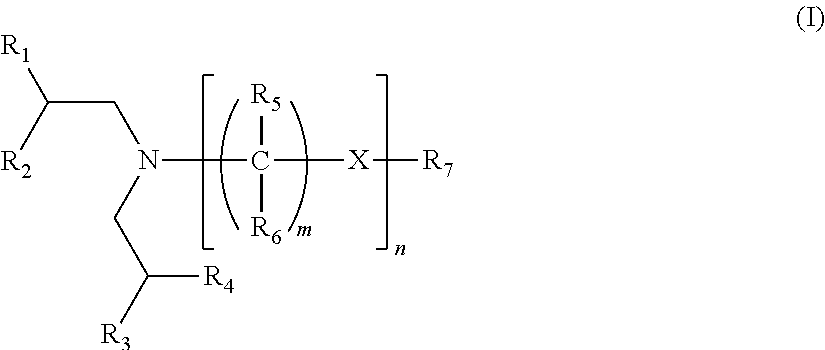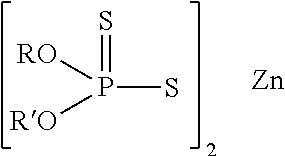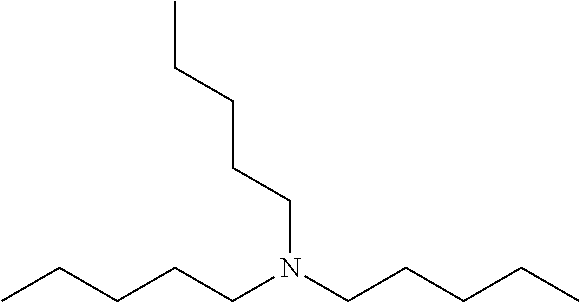Lubricating oil compositions containing sterically hindered amines as ashless TBN sources
a technology of amines and lubricating oil, which is applied in the field of new sterically hindered amines, can solve the problems of oxidation catalyst poisoning, reduced effectiveness, and claim that such lubricants will provide sufficient tbn, and achieve the effect of increasing the tbn of lubricating oil compositions and reducing the content of sash
- Summary
- Abstract
- Description
- Claims
- Application Information
AI Technical Summary
Benefits of technology
Problems solved by technology
Method used
Image
Examples
synthesis examples
Amine 1: Linear Amine—Tri-n-pentylamine (Comparative)
[0076]
[0077]Commercially available material; available from Tokyo Chemical Industry, Tokyo, Japan and TCI America, Portland Oreg., USA at 98% purity.
Amine 2: Linear Amine—Tri-n-octylamine (Comparative)
[0078]
[0079]Commercially available material; available from Alfa Aesar, a Johnson Matthey Company, Ward Hill, Mass., USA at 95% purity.
synthesis example 1
Amine 3: N,N-bis(2-ethylhexyl)dodecan-1-amine (Comparative)
[0080]
[0081]A 1 L metal reactor was charged with dodecan-1-amine (50 g, 270 mmol), 2-ethylhexanal (78 g, 582 mmol), Palladium on carbon (3 g, 1% of the amine), and ethanol (500 mL). While stirring at 600 rpm, the flow of hydrogen was set to 5.0 bars at room temperature (hydrogen was charged four times; a total of 16.8 bars of hydrogen were consumed by the reaction). The solution was then filtered over Celite and concentrated. The reaction yielded 102 g of yellow oil containing mono- and di-alkylated product. The di-alkylated product was purified and isolated by column chromatography [heptane / ethyl acetate 99.8 / 0.2], which resulted in a pale yellow oil (47 g, 43.4% yield). GC-MS confirmed the product purity to be 100.00%. 1H NMR (300 MHz, CDCl3) δ 0.86 (m, 15H), 1.26 (m, 38H), 2.08 (d, 4H), 2.26 (t, 2H).
synthesis example 2
Amine 4: 2-Ethyl-N-(2-ethylhexyl)-N-(2-methoxyethyl)hexan-1-amine (Inventive)
[0082]
[0083]2-Methoxyethanamine (10 g, 133 mmol), 2-ethylhexanal (37.6 g, 293 mmol) and dichloromethane (DCM, 40 g) were stirred at room temperature in a 250 mL 4-neck round bottom flask equipped with a reflux condenser, thermocouple, overhead stirrer and nitrogen blanket. The mixture was left to stir 3 hours. Sodium triacetoxyborohydride (STAB, 62.1 g, 293 mmol) was slowly added portion-wise to the flask. 1H NMR showed the reaction reached completion and was quenched with saturated aqueous sodium bicarbonate solution. The organic layer was washed with saturated aqueous sodium bicarbonate and brine. This layer was then dried over magnesium sulphate, filtered, and concentrated yielding a cloudy orange oil. Product was purified by column chromatography [heptane / ethyl acetate 95 / 5] resulting in a colourless oil (30.4 g, 76% yield). GC-MS confirmed the product purity to be 97%. 1H NMR (300 MHz, CDCl3) δ 0.81-0....
PUM
| Property | Measurement | Unit |
|---|---|---|
| mass % | aaaaa | aaaaa |
| mass % | aaaaa | aaaaa |
| mass % | aaaaa | aaaaa |
Abstract
Description
Claims
Application Information
 Login to View More
Login to View More - R&D
- Intellectual Property
- Life Sciences
- Materials
- Tech Scout
- Unparalleled Data Quality
- Higher Quality Content
- 60% Fewer Hallucinations
Browse by: Latest US Patents, China's latest patents, Technical Efficacy Thesaurus, Application Domain, Technology Topic, Popular Technical Reports.
© 2025 PatSnap. All rights reserved.Legal|Privacy policy|Modern Slavery Act Transparency Statement|Sitemap|About US| Contact US: help@patsnap.com



